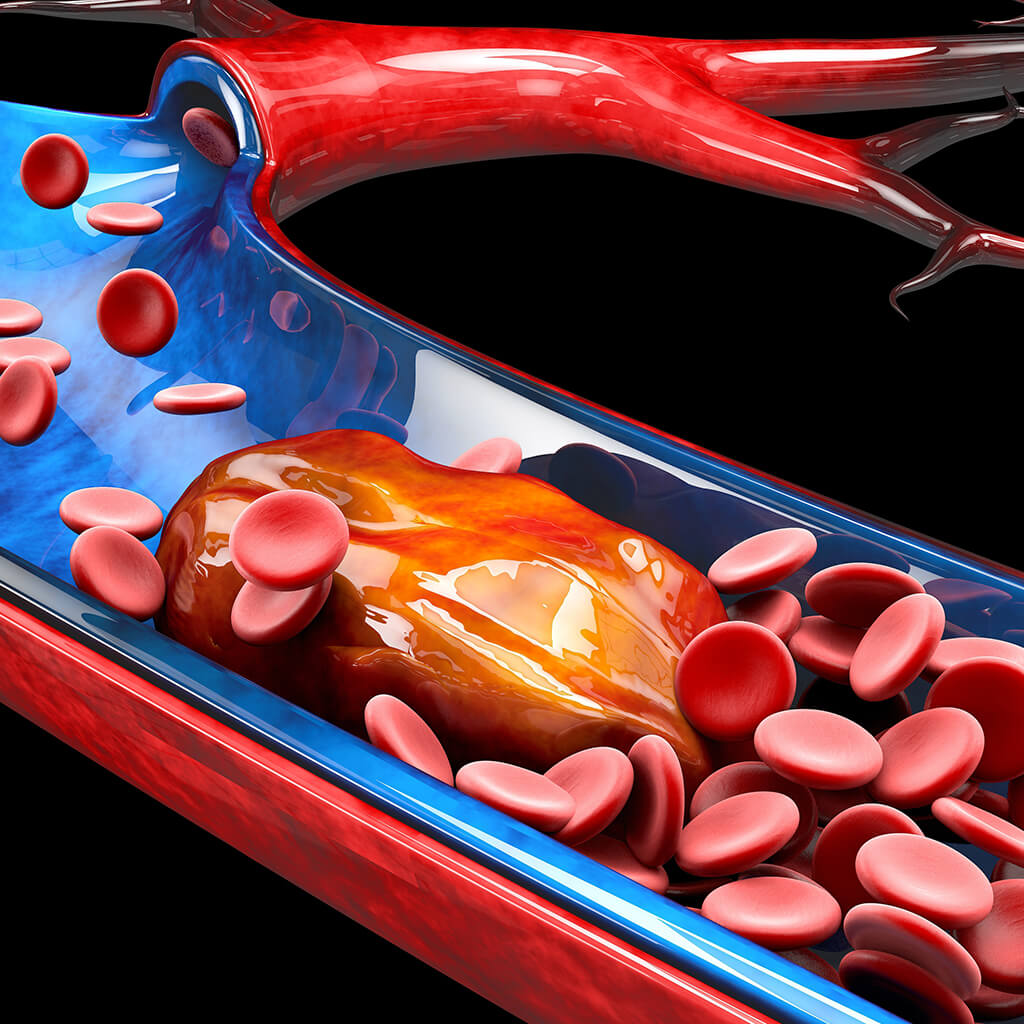Deep vein thrombosis: symptoms and treatment

Publication date: 02-06-2021
Updated on: 14-02-2023
Topic: Cardiovascular diseases
Estimated reading time: 1 min

Article Author
Communication Team GSD
Medical Editor
Paolo Carlo Righini
Editor and Translator
Viktoryia LuhakovaThe formation of a thrombus in the limbs can have different severities. The vascular surgeon at IRCCS Policlinico San Donato explains the differences, causes and symptoms.
Talking about venous thrombosis in the limbs is not enough. It is necessary to specify whether it is deep vein thrombosis or superficial vein thrombosis: two very different conditions, often confused, with different origins, frequency and causes.
Dr. Paolo Carlo Righini, Vascular Surgeon referent of the clinical area of the Unit of Vascular and Endovascular Surgery of IRCCS Policlinico San Donato, explains what is venous thrombosis, what are the symptoms and how to treat it.
Deep and superficial venous thrombosis: what they are
"First of all, it is appropriate to distinguish the venous systems that pass through the human body – explains the doctor, - the deep venous system is more responsible for the true venous return of blood to the centre of the body, to the heart.
The superficial venous system is responsible for making the venous blood of the most superficial part (i.e. skin, subcutaneous and supra-fascial district) converge towards the deep venous circle, and therefore the right cardiac chambers.
If the thrombus, namely blood clot, is formed in the superficial venous system we speak of superficial venous thrombosis, also known as superficial thrombophlebitis.
If, on the other hand, it’s a deep venous thrombosis (DVT) case, the deep venous system is involved.
Thrombophlebitis or superficial venous thrombosis
"Superficial venous thrombosis is an event that can involve the upper limb, but more frequently affects the lower limb.
Let's talk about the well-known varicose veins: the veins are dilated, the blood flows more slowly, the vessel walls have damage that expose adhesion molecules that can promote pro-thrombotic conditions.
The consequences are:
- the formation of a clot in the vein, a thrombus;
- inflammation of the subcutaneous fatty tissue near the vein.
The skin becomes red at a superficial level. In this case we speak of thrombophlebitis'.
The veins of the superficial venous system involved can be:
- in the legs
- the great saphenous vein
- the small saphenous vein
- the extra saphenous collaterals
- in the arms the basilic vein
- the cephalic vein.
Causes
What are the causes? "Thrombophlebitis can be a consequence of a blow, trauma or very prolonged exertion.
There are cases of superficial venous thrombosis in healthy veins in patients who have run the marathon, a very intense and repeated effort.
In the upper limbs, moreover, it can be a consequence of a blood draw, which can be resolved by applying heparin ointments and/or taking low molecular weight heparin under the skin.
All superficial thrombophlebitis are not worrisome events, because the superficial venous system is an accessory system: even in the presence of a thrombus remains in a small stretch of a vein, it is not a particularly serious condition”, describer Dr. Righini.
DVT: deep vein thrombosis in the limbs
The situation is different if the blood clot forms in a vein which is itself the true venous return system of the limb, that is the blood returning from the foot to the heart.
In the lower limbs it could involve:
- the tibial veins
- the sural veins
- the popliteal vein
- superficial femoral vein
- the deep femoral vein
- the common femoral vein.
It can also occur in the iliac veins, which go into the abdomen, and the inferior vena cava or superior vena cava system, which directs blood from the lower or upper half of the body, respectively, towards the heart.
Symptoms and causes
"If a clot forms in these veins, the manifestations are different and a more serious clinical picture is presented than in thrombophlebitis: in the case of DVT of the limb, we will see the appearance of swelling, heat, and in many cases fever."
The causes can be several, not attributable to trauma:
- Tumors, because some neoplasms are associated with a pro-thrombotic situation that increases the possibility of clot formation in the veins;
- Thrombophilias: congenital abnormalities of blood coagulation that characterize pathologies such as mutation of Leiden factor V, a deficiency of coagulation protein C or protein S, the LAC factor (lupus anticoagulant), which can even affect young people;
- Major abdominal, orthopedic, gynecologic surgery, or any cause of prolonged breastfeeding. When we walk, in fact, our muscles contract and contract the veins: this contributes to the venous return of blood and the flow of venous blood. Prolonged breastfeeding, by eliminating the "muscle pump", decreases the venous return and facilitate the formation (in predisposed individuals) of deep vein thrombosis: heparin prophylaxis is therefore essential. The greatest risk is that the clot migrates to the centre, which can be the cause of pulmonary embolism. For this reason, using therapeutic graduated compression stockings is associated.
- Electrophysiology procedures, for the placement of defibrillators/pacemakers, which involve the insertion of catheters in the subclavian vein and that can, in rare cases and in predisposed individuals, contribute to the formation of clots, especially in procedures of reimplantation or replacement of previously implanted catheters.
Diagnosis
"Deep vein thrombosis happens when three factors occur:
- alteration of blood flow velocity
- endothelial damage (abnormality of the inner surface of the vessel)
- hypercoagulability, which describe the so-called Virchow's Triad
The diagnosis is clinical: the limb is swollen, because the blood is struggling to return to the centre, painful, warm, the patient may have fever.
In addition, by performing an echocolordoppler, the flow of blood in the vein can be checked and whether it is compressible or not (ultrasonographic compression - CUS). If it is not compressible, a clot is present.
It is also important to conduct blood tests in patients who know they have a family history of coagulation/thrombophilia disorders, who are aware of relatives with specific genetic mutations or are affected by cancer.
If edemas appear, venous echocolordoppler should be performed immediately and the presence of D-dimer in the blood should be checked. If the D-dimer protein is absent, it rules out deep vein thrombosis; if it is elevated, it does not necessarily indicate DVT, except for extremely high values and typical associated clinical signs.
When the inflammation affects the superficial veins, in case of thrombophlebitis, it is easier to recognize the pathology. "You can feel the clot in the vein, which is hard and painful to palpation, and the skin shows redness and stiffness in the areas around the vein involved in the thrombophlebitic process".
Prevention and therapy
If recognized early, episodes of venous thrombosis, even deep, do not represent today a particularly serious problem today.
"Thanks to anticoagulant therapy (with NAO and TAO drugs), clots are dissolved and the risk of worsening deep vein thrombosis or the onset of pulmonary embolism is decreased. The use of therapeutic elastic graduated compression stocking lowers the risk of clot formation, proximal migration of clots and the appearance of edema".
The presence of varicose veins is a risk factor for superficial venous thrombosis/thrombophlebitis. "This is why it is helpful to have an echocolordoppler and a framing examination with the vascular surgeon. It is possible to improve this condition by wearing elastic stockings, taking venotonic drugs (bioflavonoids, natural supplements that decrease the likelihood of the occurrence of phlebitis) or, possibly, undergoing surgery in the presence of true varices of the lower limbs," concludes Dr. Righini.